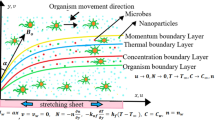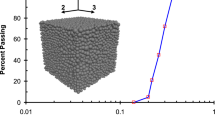Abstract
Cellular elasticity is frequently measured to investigate the biomechanical effects of drug treatment, diseases, and aging. In light of the cellular viscosity property exhibited by filament actin networks, this study investigates the viscoelasticity alterations of the human hepatocellular carcinoma (SMMC-7721) cell subjected to fullerenol treatment by means of creep tests realized by atomic force microscopy indentation. An SMMC-7721 cell was first modeled as a sphere and then as a flattened layer with finite thickness. Both Sneddon’s solutions and the Dimitriadis model have been modified to adapt to the viscoelastic situation, which are used to fit the same indentation depth–time curves obtained by creep tests. We find that the SMMC-7721 cell’s creep behavior is well described by the two modified models and the divergence of parameters determined by the two models is justified. By fullerenol treatment, the SMMC-7721 cell exhibits a significant decrease of elastic modulus and viscosity, which is presumably due to the disruption of actin filaments. This work represents a new attempt to understand the alternation of the viscoelastic properties of cancerous cells under the treatment of fullerenol, which has the significance of comprehensively elucidating the biomechanical effects of anticancer agents (such as fullerenol) on cancer cells.








Similar content being viewed by others
References
Z. Chen, L. Ma, Y. Liu, and C. Chen: Applications of functionalized fullerenes in tumor theranostics. Theranostics 2, 238 (2012).
R. Partha and J.L. Conyers: Biomedical applications of functionalized fullerene-based nanomaterials. Int. J. Nanomed. 4, 261 (2009).
S. Bosi, R.T. Da, G. Spalluto, and M. Prato: Fullerene derivatives: An attractive tool for biological applications. Eur. J. Med. Chem. 38, 913 (2003).
J. Li, A. Takeuchi, M. Ozawa, X.H. Li, K. Saigo, and K. Kitazawa: C-60 fullerol formation catalyzed by quaternary ammonium hydroxides. J. Chem. Soc., Chem. Commun. 23, 1784 (1993).
J. Jin, Y. Dong, Y. Wang, L. Xia, and W. Gu: Fullerenol Nanoparticles with structural activity induce variable intracellular actin filament morphologies. J. Biomed. Nanotechnol. 12, 1234 (2016).
Y.T. Zhou, G.R. Guy, and B.C. Low: BNIP-Sa induces cell rounding and apoptosis by displacing p50RhoGAP and facilitating RhoA activation via its unique motifs in the BNIP-2 and Cdc42GAP homology domain. Oncogene 25, 2393 (2006).
D.N. Johnson-Lyles, K. Peifley, S. Lockett, B.W. Neun, M. Hansen, J. Clogston, S.T. Stern, and S.E. McNeil: Fullerenol cytotoxicity in kidney cells is associated with cytoskeleton disruption, autophagic vacuole accumulation, and mitochondrial dysfunction. Toxicol. Appl. Pharmacol. 248, 249 (2010).
J.D. Zhu, Z.Q. Ji, J. W, R.H. Sun, X. Zhang, Y. Gao, H. Sun, Y. Liu, Z. Wang, A. Li, J. Ma, T. Wang, G. Jia, and Y. Gu: Tumor-inhibitory effect and immunomodulatory activity of fullerol C60(OH)x. Small. 4, 1168 (2008).
L.H. Lu, Y.T. Lee, H.W. Chen, Y.C. Long, and H.C. Huang: The possible mechanisms of the antiproliferative effect of fullerenol, polyhydroxylated C60, on vascular smooth muscle cells. Br. J. Pharmacol. 123, 1097 (1998).
A. Paraskar, S. Soni, R.A. Mashelkar, and S. Sengupta: Fullerenol–cytotoxic conjugates for cancer chemotherapy. ACS Nano 3, 2505 (2009).
S. Iyer, R.M. Gaikwad, V. Subba Rao, C.D. Woodworth, and I. Sokolov: Atomic force microscopy detects differences in the surface brush of normal and cancerous cells. Nat. Nanotechnol. 4, 389 (2009).
T. Hawkins, M. Mirigian, M.S. Yasar, and J.L. Ross: Mechanics of microtubules. J. Biomech. 43, 23 (2010).
J. Mrdanović, S. Solajić, V. Bogdanović, K. Stankov, G. Bogdanovicć, and A. Djordjevic: Effects of fullerenol C60(OH)24 on the frequency of micronuclei and chromosome aberrations in CHO-K1 cells. Mutat. Res., Genet. Toxicol. Environ. Mutagen. 680, 25 (1999).
E. Siamantouras, C.E. Hills, M.Y. Younis, P.E. Squire, and K.K. Liu: Quantitative investigation of calcimimetic R568 on beta cell adhesion and mechanics using AFM single-cell force spectroscopy. FEBS Lett. 588, 1178 (2014).
G. Thomas, N.A. Burnham, T.A. Camesano, and Q. Wen: Measuring the mechanical properties of living cells using atomic force microscopy. J. Visualized Exp. 76, e50497 (2013).
C. Rianna and M. Radmacher: Cell mechanics as a marker for diseases: Biomedical applications of AFM. AIP Conf. Proc. 1760, 020057 (2016).
M.N. Starodubtseva: Mechanical properties of cells and ageing. Ageing Res. Rev. 10, 16 (2011).
R.E. Mahaffy, S. Park, E. Gerde, J. Käs, and C.K. Shih: Quantitative analysis of the viscoelastic properties of thin regions of fibroblasts using atomic force microscopy. Biophys. J. 86, 1777 (2004).
K.E. Bremmell, A. Evans, and C.A. Prestidge: Deformation and nano-rheology of red blood cells: An AFM investigation. Colloids Surf., B 50, 43 (2006).
M. Zhao and C. Srinivasan: Rate- and depth-dependent nanomechanical behavior of individual living Chinese hamster ovary cells probed by atomic force microscopy. J. Mater. Res. 21, 1906 (2006).
Q.S. Li, G.Y.H. Lee, C.N. Ong, and C.T. Lim: AFM indentation study of breast cancer cells. Biochem. Biophys. Res. Commun. 374, 609 (2008).
E.M. Darling, S. Zauscher, and F. Guilak: Viscoelastic properties of zonal articular chondrocytes measured by atomic force microscopy. Osteoarthritis Cartilage 14, 571 (2006).
E.J. Koay, A.C. Shieh, and K.A. Athanasiou: Creep indentation of single cells. J. Biomech. Eng. 125, 334 (2003).
N.D. Leipzig and K.A. Athanasiou: Unconfined creep compression of chondrocytes. J. Biomech. 38, 77 (2005).
A. Palmer, T.G. Mason, J. Xu, S.C. Kuo, and D. Wirtz: Diffusing wave spectroscopy microscopy of actin filament networks. Biophys. J. 76, 1063 (1999).
A.N. Ketene, P.C. Roberts, A.A. Shea, E.M. Schmelz, and M. Agah: Actin filaments play a primary role for structural integrity and viscoelastic response in cells. Integr. Biol. 4, 540 (2012).
A.H.W. Ngan and B. Tang: Response of power-law-viscoelastic and time-dependent materials to rate jumps. J. Mater. Res. 24, 853 (2009).
B. Tang and A.H.W. Ngan: Nanoindentation using an atomic force microscope. Philos. Mag. 91, 1329 (2011).
B. Tang and A.H.W. Ngan: Investigation of viscoelastic properties of amorphous selenium near glass transition using depth-sensing indentation. Soft Mater. 2, 125 (2004).
E.K. Dimitriadis, F. Horkay, J. Maresca, B. Kachar, and R.S. Chadwick: Determination of elastic moduli of thin layers of soft material using the atomic force microscope. Biophys. J. 82, 2798 (2002).
X.Y. Zhu, N. Zhang, Z.B. Wang, and X.P. Liu: Investigation of work of adhesion of biological cell (human hepatocellular carcinoma) by AFM nanoindentation. J. Micro-Bio Rob. 11, 47 (2016).
T. Neumann: Determining the elastic modulus of biological samples using atomic force microscopy. JPK Instruments Application Report (2008).
Y. Liu, Z.B. Wang, and X.Y. Wang: AFM-based study of fullerenol (C60(OH)24)-induced changes of elasticity in living SMCC-7721 cells. J. Mech. Behav. Biomed. Mater. 45, 65 (2015).
R.B. King: Elastic analysis of some punch problems for a layered medium. Int. J. Solids Struct. 23, 1657 (1987).
J.M. Antunes, L.F. Menezes, and J.V. Fernandes: Three-dimensional numerical simulation of Vickers indentation tests. Int. J. Solids Struct. 43, 784 (2006).
I.M. Ward and D.W. Hadley: An introduction to the mechanical properties of solid polymers, 2nd ed. (John Wiley & Sons Ltd, New York, 1993).
W.N. Findley, J.S. Lai, and K. Onaran: Creep and Relaxation of Nonlinear Viscoelastic Materials with an Introduction to Linear Viscoelasticity, 3rd ed. (Dover Publications, Inc, New York, 1989).
C.E. Hills, M.Y. Younis, J. Bennett, E. Siamantouras, K.K. Liu, and P.E. Squires: Calcium-sensing receptor activation increases cell–cell adhesion and β-cell function. Cell. Physiol. Biochem. 30, 575 (2012).
J. Chen: Nanobiomechanics of living cells: A review. J. R. Soc., Interface 4, 20130055 (2014).
I.N. Sneddon: The relation between load and penetration in the axisymmetric Boussinesq problem for a punch of arbitrary profile. Int. J. Eng. Sci. 3, 47 (1965).
E.H. Lee and J.R.M. Radok: The contact problem for viscoelastic bodies. J. Appl. Mech. 27, 438 (1960).
T.C.T. Ting: The contact stresses between a rigid indenter and a viscoelastic half-space. J. Appl. Mech. 33, 845 (1966).
H.L. Yu, Z. Li, and Q.J. Wang: Viscoelastic-adhesive contact modeling: Application to the characterization of the viscoelastic behavior of materials. Mech. Mater. 60, 55 (2013).
J. Chen and G. Lu: Finite element modelling of nanoindentation based methods for mechanical properties of cells. J. Biomech. 45, 2810 (2012).
J. Chen: Understanding the nanoindentation mechanisms of a microsphere for biomedical applications. J. Phys. D: Appl. Phys. 46, 495303 (2013).
J. Sanchez-Adams, R.E. Wilusz, and F. Guilak: Atomic force microscopy reveals regional variations in the micromechanical properties of the pericellular and extracellular matrices of the meniscus. J. Orthop. Res. 31, 1218 (2013).
N. Gavara and R.S. Chadwick: Determination of the elastic moduli of thin samples and adherent cells using conical atomic force microscope tips. Nat. Nanotechnol. 7, 733 (2012).
V. Vadillo-Rodriguez, T.J. Beveridge, and J.R. Dutcher: Surface viscoelasticity of individual Gram-negative bacterial cells measured using atomic force microscopy. J. Bacteriol. 190, 4225 (2008).
Z.L. Zhou, A.H.W. Ngan, B. Tang, and A.X. Wang: Reliable measurement of elastic modulus of cells by nanoindentation in an atomic force microscope. J. Mech. Behav. Biomed. Mater. 8, 134 (2012).
L. Sirghi, J. Ponti, F. Broggi, and F. Rossi: Probing elasticity and adhesion of live cells by atomic force microscopy indentation. Eur. Biophys. J. 37, 935 (2008).
X.Y. Zhu, E. Siamantouras, K.K. Liu, and X.P. Liu: Determination of work of adhesion of biological cell under AFM bead indentation. J. Mech. Behav. Biomed. Mater. 56, 77 (2015).
ACKNOWLEDGMENTS
The authors are grateful for the technical supports from the Laboratory of Precision Engineering and Surfaces of the University of Warwick and the International Research Centre for Nano Handling and Manufacturing, Changchun University of Science and Technology. This project has been partially funded by the European Union’s Horizon 2020 research and innovation programme under the Marie Skłodowska-Curie grant agreement No. 644971 and the China-EU research programme (S2016G4501).
Author information
Authors and Affiliations
Corresponding author
Rights and permissions
About this article
Cite this article
Zhu, X., Wang, Z. & Liu, X. Investigation of effect of fullerenol on viscoelasticity properties of human hepatocellular carcinoma by AFM-based creep tests. Journal of Materials Research 32, 2521–2531 (2017). https://doi.org/10.1557/jmr.2017.229
Received:
Accepted:
Published:
Issue Date:
DOI: https://doi.org/10.1557/jmr.2017.229




